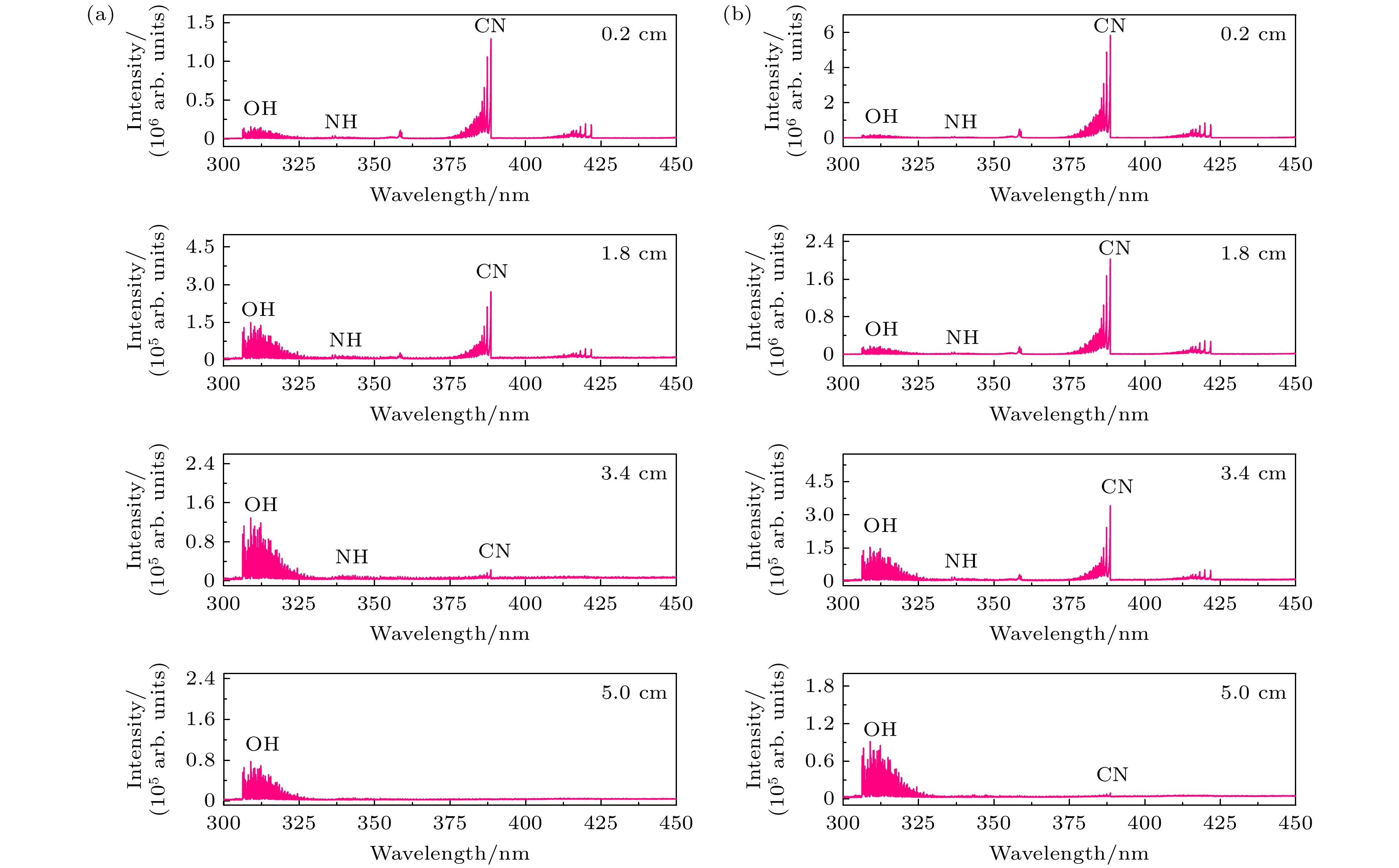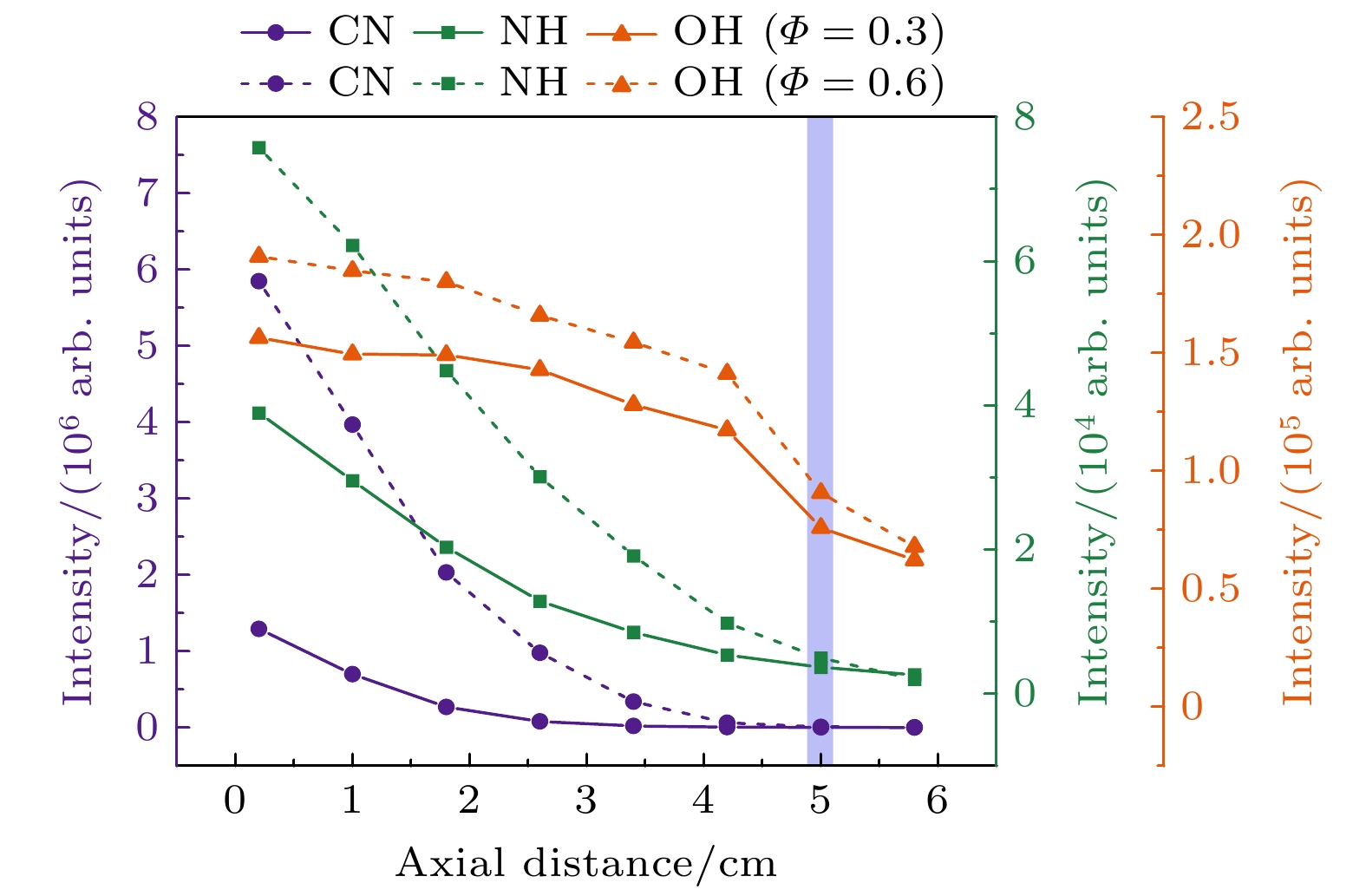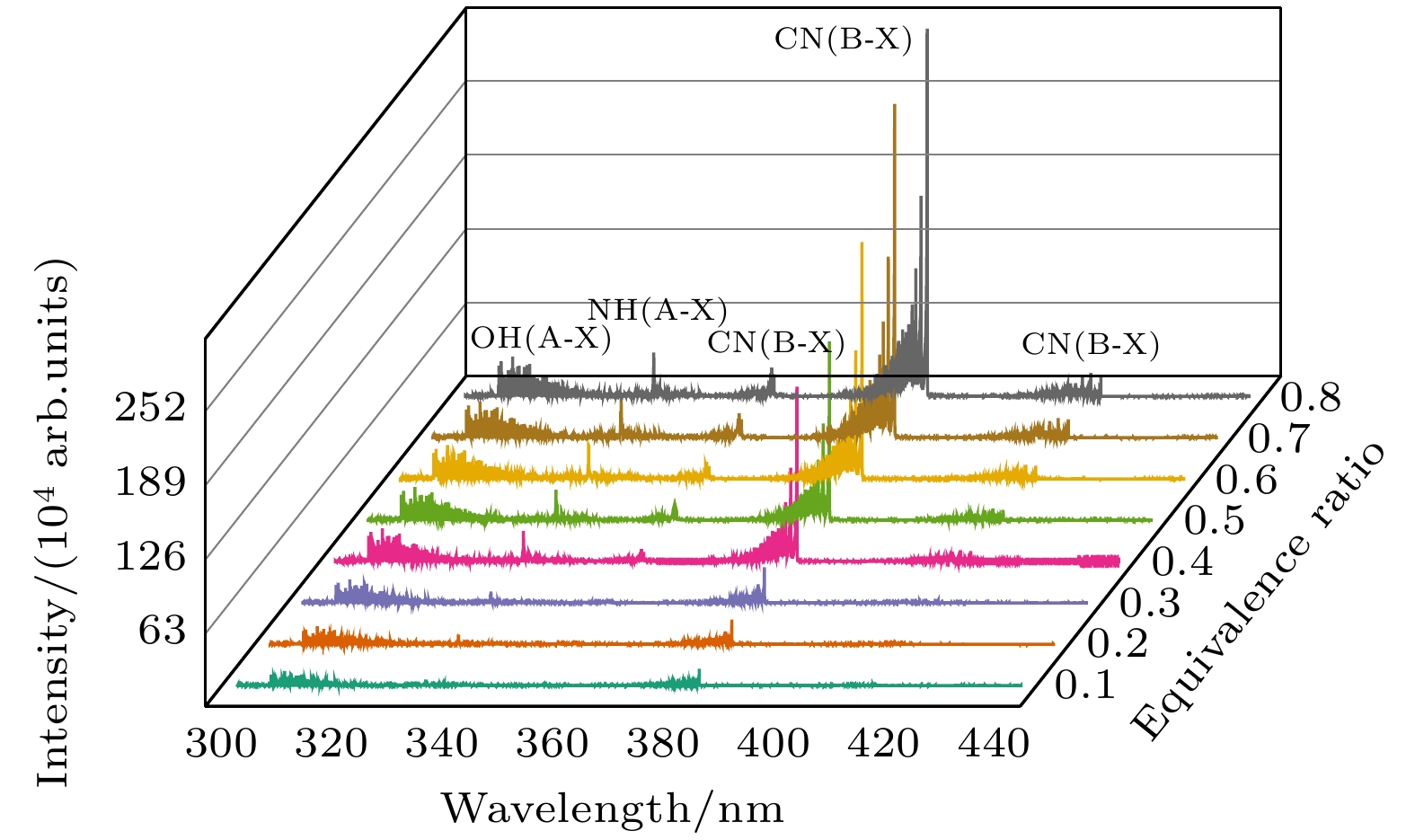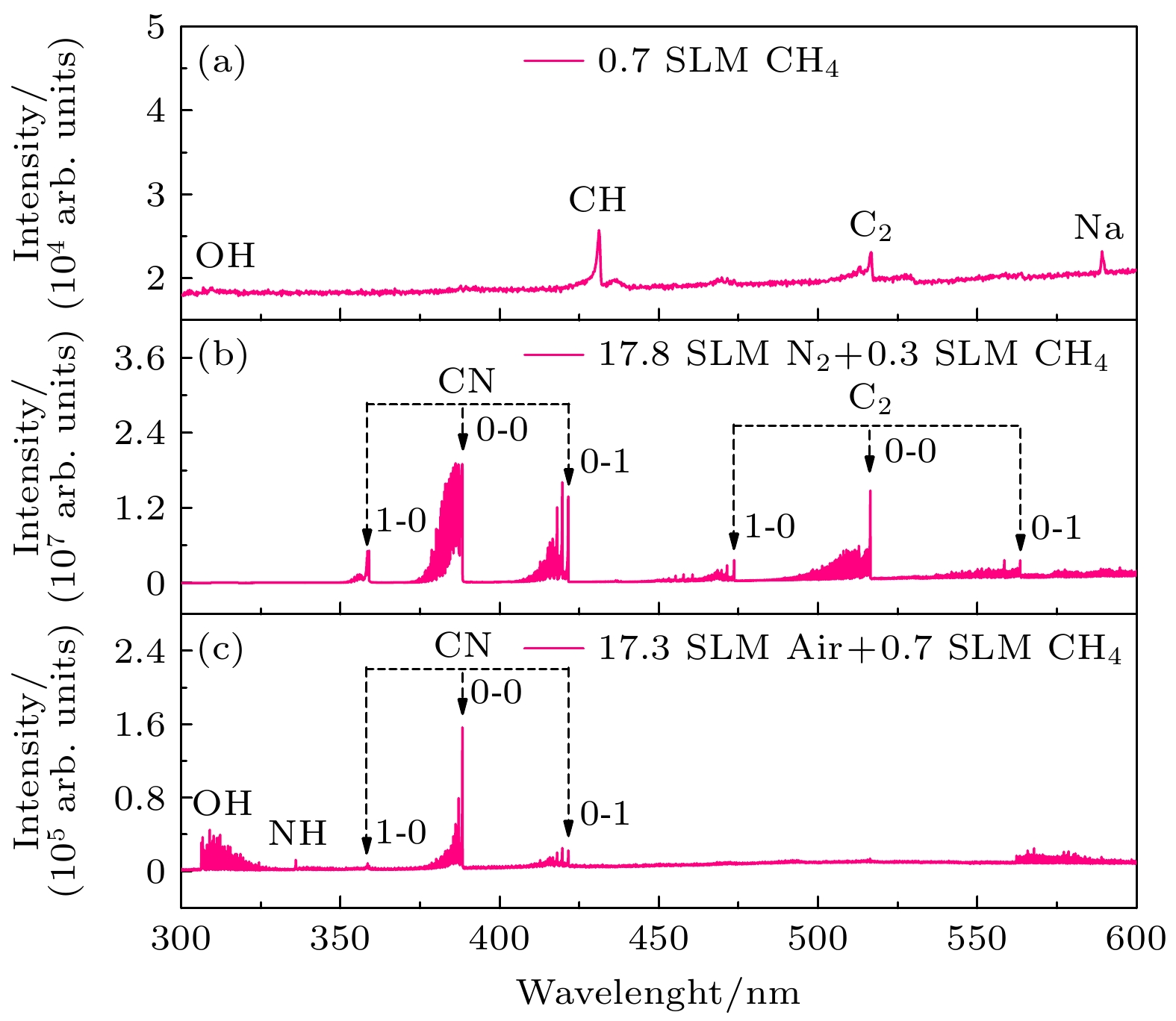-
开展了预混甲烷(CH4)和空气的微波等离子体放电燃烧实验, 研究火焰余辉形态、光谱分布和温度特性随着微波功率、燃空当量比和轴向观测位置的变化规律. 实验发现预混CH4/Air的稀薄燃烧极限当量比Φ = 0.4; 在微波等离子体放电时, 当Φ < 0.4, 以放电诱导的燃烧过程为主要特征, 而当Φ ≥ 0.4时, 等离子体放电燃烧的中心区会明显收缩并逐渐出现丝状放电, 这里低约化场强区的燃烧和高约化场强区的放电燃烧相互影响. 利用发射光谱仪测得预混CH4/Air微波等离子体放电燃烧光谱的特征谱带, OH(A-X), NH(A-X)和CN(B-X), 沿着轴向空间位置的强度分布和随着当量比的变化, 发现了轴向上近余辉的等离子体放电燃烧区和远余辉的燃烧区, 并通过分析CN(B-X)振转谱带的强度分布, 计算得到振动与转动温度, 发现以Φ = 0.4为分界点形成两种不同的随当量比变化规律. 最后, 根据CH4扩散燃烧火焰、CH4/N2混合气体等离子体放电以及CH4/Air混合气体等离子体放电燃烧的发射光谱对比分析讨论了等离子体增强燃烧过程中的反应路径和机理.In this work, we carry out the experiments on an atmospheric-pressure premixed methane and air microwave plasma discharge combustion with premixed methane and air to study the morphology, the spatial distribution of species, and the temperature characteristics for various microwave power values and methane-to-air equivalent ratios (Φ) at a series of measurement positions. The experimental results show that the equivalent ratio of 0.4 corresponds to the limit value for lean-combustion of premixed methane and air. And for Φ < 0.4, the discharge flame is mainly characterized by the combustion induced by premixed methane and air microwave plasma discharge, while, for Φ ≥ 0.4, the discharge flame is constricted into filaments radially, and the natural combustion occurs in the region of low reduced electric strength and the combustion induced by plasma discharge in the region of high reduced electric strength, which affect each other. The variations of emission intensity of OH (A-X) band, NH (A-X) band and CN (B-X) band with the measuring position and the equivalent ratio Φ are measured by using optical emission spectrometry (OES). It is found that the discharge combustion occurs in near afterglow and the combustion in far afterglow. And the vibrational temperature and the rotational temperature of the plasma discharge combustion are determined by analyzing the emission bands of CN(B-X) and the variations of both vibrational and rotational temperatures with equivalent ratio, exhibiting very different varying tendencies for cases of Φ < 0.4 and Φ ≥ 0.4, respectively. Finally, the reaction pathway and mechanism are discussed on the basis of the comparative analyses of the emission spectra of CH4 diffusion combustion flame, premixed methane and nitrogen microwave plasma discharge, and premixed methane and air microwave plasma discharge combustion.
-
Keywords:
- atmospheric pressure /
- microwave plasma /
- discharge /
- methane
[1] Chu S, Majumdar A 2012 Nature 488 294
 Google Scholar
Google Scholar
[2] Starikovskaia S M 2014 J. Phys. D: Appl. Phys. 47 353001
 Google Scholar
Google Scholar
[3] Denissenko P, Bulat M P, Esakov I I, Grachev L P, Volkov K N, Volobuev I A, Upyrev V, Bulat P V 2019 Combust. Flame 202 417
 Google Scholar
Google Scholar
[4] Ju Y G, Sun W T 2015 Prog. Energy Combust. Sci. 48 21
 Google Scholar
Google Scholar
[5] Sun W T, Uddi M, Won S H, Ombrello T, Carter C, Ju Y G 2012 Combust. Flame 159 221
 Google Scholar
Google Scholar
[6] Tang Y, Sun J G, Shi B L, Li S Q, Yao Q 2021 Combust. Flame 231 111483
 Google Scholar
Google Scholar
[7] Kim W, Mungal M G, Cappelli M A 2010 Combust. Flame 157 374
 Google Scholar
Google Scholar
[8] Sun W T, Uddi M, Ombrello T, Won S H, Carter C, Ju Y G 2011 Proc. Combust. Inst. 33 3211
 Google Scholar
Google Scholar
[9] Starikovskiy A, Aleksandrov N 2013 Prog. Energy Combust. Sci. 39 61
 Google Scholar
Google Scholar
[10] Mu H B, Yu L, Li P, Tang C L, Wang J H, Zhang G J 2015 Plasma Sci. Technol. 17 1019
 Google Scholar
Google Scholar
[11] Ono R, Ogura K, Mogi T 2017 J. Phys. D:Appl. Phys. 50 365201
 Google Scholar
Google Scholar
[12] Redondo A B, Troussard E, van Bokhoven J A 2012 Fuel Process. Technol. 104 265
 Google Scholar
Google Scholar
[13] Cruccolini V, Discepoli G, Cimarello A, Battistoni M, Mariani F, Grimaldi C N, Dal Re M 2020 Fuel 259 116290
 Google Scholar
Google Scholar
[14] Chintala N, Bao A, Lou G F, Adamovich I V 2006 Combust. Flame 144 744
 Google Scholar
Google Scholar
[15] Wolk B, DeFilippo A, Chen J Y, Dibble R, Nishiyama A, Ikeda Y 2013 Combust. Flame 160 1225
 Google Scholar
Google Scholar
[16] Ehn A, Petersson P, Zhu J J, Li Z S, Aldén M, Nilsson E J K, Larfeldt J, Larsson A, Hurtig T, Zettervall N, Fureby C 2017 Proc. Combust. Inst. 36 4121
 Google Scholar
Google Scholar
[17] Zhang X L, Niu Y L, Li S Z, Cao S L, Ji C J 2021 Phys. Plasmas 28 123511
 Google Scholar
Google Scholar
[18] Li S Z, Niu Y L, Cao S L, Zhang J, Zhang J L, Li X C 2022 J. Phys. D: Appl. Phys. 55 235203
 Google Scholar
Google Scholar
[19] Mao X Q, Chen Q, Guo C H 2019 Energy Convers. Manage. 200 112018
 Google Scholar
Google Scholar
[20] Kang H, Choi S, Jung C M, Kim K T, Song Y H, Lee D H 2020 Int. J. Hydrogen Energy 45 30009
 Google Scholar
Google Scholar
[21] Feng R, Li J, Wu Y, Jia M, Jin D 2020 Aerosp. Sci. Technol. 99 105752
 Google Scholar
Google Scholar
[22] Hong Y C, Uhm H S 2006 Phys. Plasmas 13 113501
 Google Scholar
Google Scholar
[23] Wang C J, Wu W 2013 J. Phys. D: Appl. Phys. 46 464008
 Google Scholar
Google Scholar
[24] Wu W, Fuh C A, Wang C J 2015 Combust. Sci. Technol. 187 999
 Google Scholar
Google Scholar
[25] Fuh C A, Wang C J 2020 IEEE Trans. Plasma Sci. 48 2646
 Google Scholar
Google Scholar
[26] Hemawan K W, Wichman I S, Lee T, Grotjohn T A, Asmussen J 2009 Rev. Sci. Instrum. 80 053507
 Google Scholar
Google Scholar
[27] Dedic C E, Michael J B 2021 Combust. Flame 227 322
 Google Scholar
Google Scholar
[28] Wu W, Fuh C A, Wang C J 2015 IEEE Trans. Plasma Sci. 43 3986
 Google Scholar
Google Scholar
[29] Wang Z, Huang J, Wang Q, Hou L Y, Zhang G X 2015 Combust. Flame 162 2561
 Google Scholar
Google Scholar
[30] Stockman E S, Zaidi S H, Miles R B, Carter C D, Ryan M D 2009 Combust. Flame 156 1453
 Google Scholar
Google Scholar
[31] Hammack S, Lee T, Carter C 2012 IEEE Trans. Plasma Sci. 40 3139
 Google Scholar
Google Scholar
[32] Michael J B, Chng T L, Miles R B 2013 Combust. Flame 160 796
 Google Scholar
Google Scholar
[33] Li Y H, Chen C T, Fang H K 2019 Energy 188 116007
 Google Scholar
Google Scholar
[34] Hwang J, Bae C, Park J, Choe W, Cha J, Woo S 2016 Combust. Flame 167 86
 Google Scholar
Google Scholar
[35] Ward M A V 1980 J. Microwave Power 15 193
 Google Scholar
Google Scholar
[36] Chen B S, Garner A L, Bane S P M 2019 Combust. Flame 207 250
 Google Scholar
Google Scholar
[37] Zhang X H, Wang Z W, Wu H M, Zhou D, Huang S, Cheng X B, Chen J Y 2020 Combust. Flame 222 111
 Google Scholar
Google Scholar
[38] Kammermann T, Kreutner W, Trottmann M, Merotto L, Soltic P, Bleiner D 2018 Spectrochim. Acta Part B 148 152
 Google Scholar
Google Scholar
[39] Kojima J, Ikeda Y, Nakajima T 2005 Combust. Flame 140 34
 Google Scholar
Google Scholar
[40] Fuh C A, Clark S M, Wu W, Wang C J 2016 J. Appl. Phys. 120 163303
 Google Scholar
Google Scholar
[41] 陈泽煜, 彭玉彬, 王瑞, 贺永宁, 崔万照 2022 71 240702
 Google Scholar
Google Scholar
Chen Z Y, Peng Y B, Wang R, He Y N, Cui W Z 2022 Acta Phys. Sin. 71 240702
 Google Scholar
Google Scholar
[42] Zhu X R, Khateeb A A, Roberts W L, Guiberti T F 2021 Combust. Flame 231 111508
 Google Scholar
Google Scholar
[43] Dilecce G, Ambrico P F, Scarduelli G, Tosi P, De Benedictis S 2009 Plasma Sources Sci. Technol. 18 015010
 Google Scholar
Google Scholar
[44] Hu W, Tang J Y, Wu J D, Sun J, Shen Y Q, Xu X F, Xu N 2008 Phys. Plasmas 15 073502
 Google Scholar
Google Scholar
-
图 4 在总气流量为18 SLM、微波功率为1200 W时, 当量比分别为 (a) Φ = 0.3和 (b) Φ = 0.6下的沿x轴空间分辨发射光谱图
Fig. 4. Spatial distribution of emission spectra at a series of positions along x axis at the equivalence ratio of (a) 0.3 and (b) 0.6, respectively, with the fixed total gas flow rate of 18 SLM and microwave power of 1200 W.
图 9 在总气流量为18 SLM条件下, (a)微波功率分别为1200 W, 1400 W和1600 W时, 由CN谱带确定的转动温度随当量比的变化曲线; (b)当量比分别为0.1, 0.2, 0.3, 0.4, 0.5, 0.6, 0.7以及0.8时, 转动温度随微波功率的变化曲线
Fig. 9. Plot of the rotational temperature determined from CN bands versus (a) the equivalent ratio at a series of microwave power and (b) microwave power at various equivalent ratios, respectively, at a fixed total gas flow rate of 18 SLM.
图 11 在总气流量为18 SLM条件下, (a)微波功率分别为1200 W, 1400 W和1600 W时, 由CN谱带确定的振动温度随当量比的变化曲线; (b)当量比分别为0.1, 0.2, 0.3, 0.4, 0.5, 0.6, 0.7以及0.8时, 振动温度随微波功率的变化曲线
Fig. 11. Plot of the vibrational temperature determined from CN bands versus (a) the equivalent ratio at a series of microwave power and (b) microwave power at various equivalent ratios, respectively, at a fixed total gas flow rate of 18 SLM.
图 12 (a) CH4在空气中扩散燃烧时的发射光谱图; (b) CH4/N2按照0.3∶17.8比例预混微波等离子体放电发射光谱图(微波功率1200 W); (c) CH4/Air按照0.7∶17.3比例预混时微波等离子体放电燃烧的发射光谱图(微波功率1200 W)
Fig. 12. Emission spectra of (a) CH4 diffusion combustion in the ambient air without microwave plasma discharge; (b) microwave plasma discharge in CH4/N2 with mixing ratio of 0.3∶17.8 (microwave power of 1200 W); (c) microwave plasma discharge and combustion in CH4/Air with mixing ratio of 0.7∶17.3, respectively (microwave power of 1200 W).
-
[1] Chu S, Majumdar A 2012 Nature 488 294
 Google Scholar
Google Scholar
[2] Starikovskaia S M 2014 J. Phys. D: Appl. Phys. 47 353001
 Google Scholar
Google Scholar
[3] Denissenko P, Bulat M P, Esakov I I, Grachev L P, Volkov K N, Volobuev I A, Upyrev V, Bulat P V 2019 Combust. Flame 202 417
 Google Scholar
Google Scholar
[4] Ju Y G, Sun W T 2015 Prog. Energy Combust. Sci. 48 21
 Google Scholar
Google Scholar
[5] Sun W T, Uddi M, Won S H, Ombrello T, Carter C, Ju Y G 2012 Combust. Flame 159 221
 Google Scholar
Google Scholar
[6] Tang Y, Sun J G, Shi B L, Li S Q, Yao Q 2021 Combust. Flame 231 111483
 Google Scholar
Google Scholar
[7] Kim W, Mungal M G, Cappelli M A 2010 Combust. Flame 157 374
 Google Scholar
Google Scholar
[8] Sun W T, Uddi M, Ombrello T, Won S H, Carter C, Ju Y G 2011 Proc. Combust. Inst. 33 3211
 Google Scholar
Google Scholar
[9] Starikovskiy A, Aleksandrov N 2013 Prog. Energy Combust. Sci. 39 61
 Google Scholar
Google Scholar
[10] Mu H B, Yu L, Li P, Tang C L, Wang J H, Zhang G J 2015 Plasma Sci. Technol. 17 1019
 Google Scholar
Google Scholar
[11] Ono R, Ogura K, Mogi T 2017 J. Phys. D:Appl. Phys. 50 365201
 Google Scholar
Google Scholar
[12] Redondo A B, Troussard E, van Bokhoven J A 2012 Fuel Process. Technol. 104 265
 Google Scholar
Google Scholar
[13] Cruccolini V, Discepoli G, Cimarello A, Battistoni M, Mariani F, Grimaldi C N, Dal Re M 2020 Fuel 259 116290
 Google Scholar
Google Scholar
[14] Chintala N, Bao A, Lou G F, Adamovich I V 2006 Combust. Flame 144 744
 Google Scholar
Google Scholar
[15] Wolk B, DeFilippo A, Chen J Y, Dibble R, Nishiyama A, Ikeda Y 2013 Combust. Flame 160 1225
 Google Scholar
Google Scholar
[16] Ehn A, Petersson P, Zhu J J, Li Z S, Aldén M, Nilsson E J K, Larfeldt J, Larsson A, Hurtig T, Zettervall N, Fureby C 2017 Proc. Combust. Inst. 36 4121
 Google Scholar
Google Scholar
[17] Zhang X L, Niu Y L, Li S Z, Cao S L, Ji C J 2021 Phys. Plasmas 28 123511
 Google Scholar
Google Scholar
[18] Li S Z, Niu Y L, Cao S L, Zhang J, Zhang J L, Li X C 2022 J. Phys. D: Appl. Phys. 55 235203
 Google Scholar
Google Scholar
[19] Mao X Q, Chen Q, Guo C H 2019 Energy Convers. Manage. 200 112018
 Google Scholar
Google Scholar
[20] Kang H, Choi S, Jung C M, Kim K T, Song Y H, Lee D H 2020 Int. J. Hydrogen Energy 45 30009
 Google Scholar
Google Scholar
[21] Feng R, Li J, Wu Y, Jia M, Jin D 2020 Aerosp. Sci. Technol. 99 105752
 Google Scholar
Google Scholar
[22] Hong Y C, Uhm H S 2006 Phys. Plasmas 13 113501
 Google Scholar
Google Scholar
[23] Wang C J, Wu W 2013 J. Phys. D: Appl. Phys. 46 464008
 Google Scholar
Google Scholar
[24] Wu W, Fuh C A, Wang C J 2015 Combust. Sci. Technol. 187 999
 Google Scholar
Google Scholar
[25] Fuh C A, Wang C J 2020 IEEE Trans. Plasma Sci. 48 2646
 Google Scholar
Google Scholar
[26] Hemawan K W, Wichman I S, Lee T, Grotjohn T A, Asmussen J 2009 Rev. Sci. Instrum. 80 053507
 Google Scholar
Google Scholar
[27] Dedic C E, Michael J B 2021 Combust. Flame 227 322
 Google Scholar
Google Scholar
[28] Wu W, Fuh C A, Wang C J 2015 IEEE Trans. Plasma Sci. 43 3986
 Google Scholar
Google Scholar
[29] Wang Z, Huang J, Wang Q, Hou L Y, Zhang G X 2015 Combust. Flame 162 2561
 Google Scholar
Google Scholar
[30] Stockman E S, Zaidi S H, Miles R B, Carter C D, Ryan M D 2009 Combust. Flame 156 1453
 Google Scholar
Google Scholar
[31] Hammack S, Lee T, Carter C 2012 IEEE Trans. Plasma Sci. 40 3139
 Google Scholar
Google Scholar
[32] Michael J B, Chng T L, Miles R B 2013 Combust. Flame 160 796
 Google Scholar
Google Scholar
[33] Li Y H, Chen C T, Fang H K 2019 Energy 188 116007
 Google Scholar
Google Scholar
[34] Hwang J, Bae C, Park J, Choe W, Cha J, Woo S 2016 Combust. Flame 167 86
 Google Scholar
Google Scholar
[35] Ward M A V 1980 J. Microwave Power 15 193
 Google Scholar
Google Scholar
[36] Chen B S, Garner A L, Bane S P M 2019 Combust. Flame 207 250
 Google Scholar
Google Scholar
[37] Zhang X H, Wang Z W, Wu H M, Zhou D, Huang S, Cheng X B, Chen J Y 2020 Combust. Flame 222 111
 Google Scholar
Google Scholar
[38] Kammermann T, Kreutner W, Trottmann M, Merotto L, Soltic P, Bleiner D 2018 Spectrochim. Acta Part B 148 152
 Google Scholar
Google Scholar
[39] Kojima J, Ikeda Y, Nakajima T 2005 Combust. Flame 140 34
 Google Scholar
Google Scholar
[40] Fuh C A, Clark S M, Wu W, Wang C J 2016 J. Appl. Phys. 120 163303
 Google Scholar
Google Scholar
[41] 陈泽煜, 彭玉彬, 王瑞, 贺永宁, 崔万照 2022 71 240702
 Google Scholar
Google Scholar
Chen Z Y, Peng Y B, Wang R, He Y N, Cui W Z 2022 Acta Phys. Sin. 71 240702
 Google Scholar
Google Scholar
[42] Zhu X R, Khateeb A A, Roberts W L, Guiberti T F 2021 Combust. Flame 231 111508
 Google Scholar
Google Scholar
[43] Dilecce G, Ambrico P F, Scarduelli G, Tosi P, De Benedictis S 2009 Plasma Sources Sci. Technol. 18 015010
 Google Scholar
Google Scholar
[44] Hu W, Tang J Y, Wu J D, Sun J, Shen Y Q, Xu X F, Xu N 2008 Phys. Plasmas 15 073502
 Google Scholar
Google Scholar
计量
- 文章访问数: 6269
- PDF下载量: 108
- 被引次数: 0













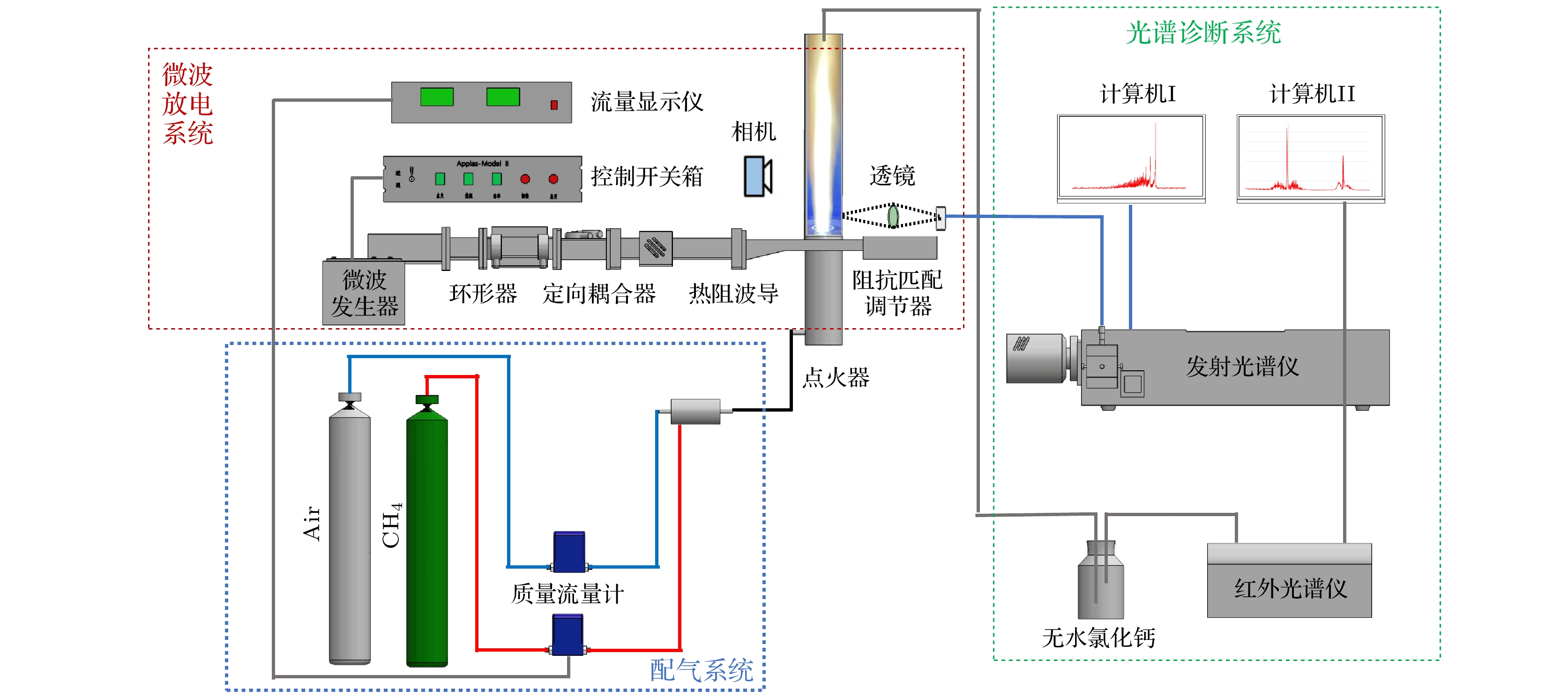
 下载:
下载:


